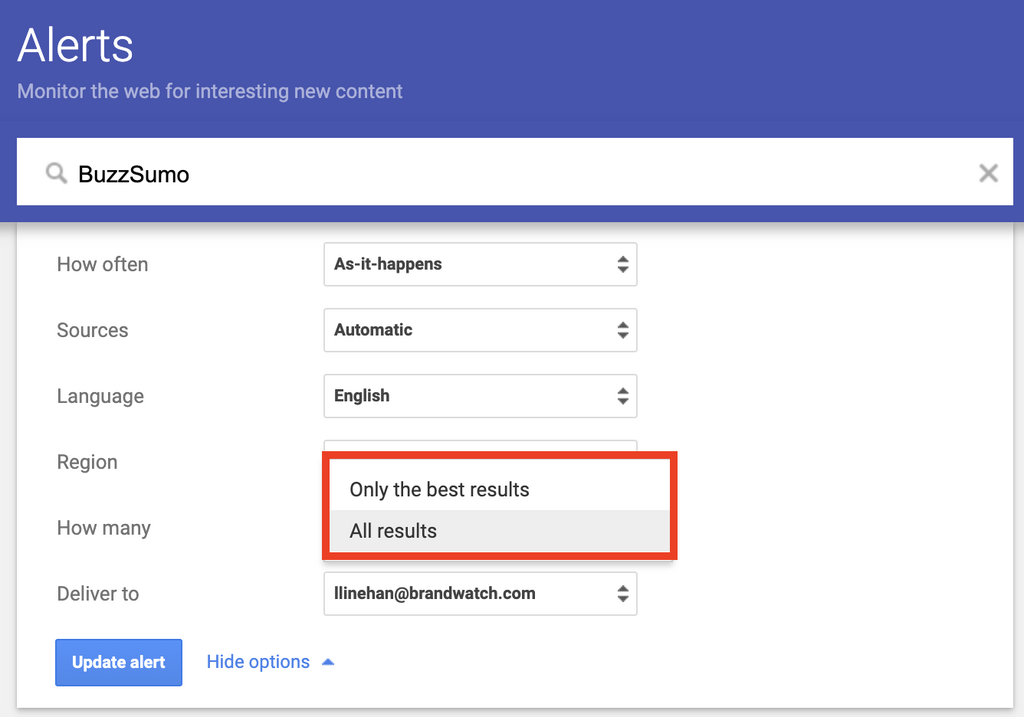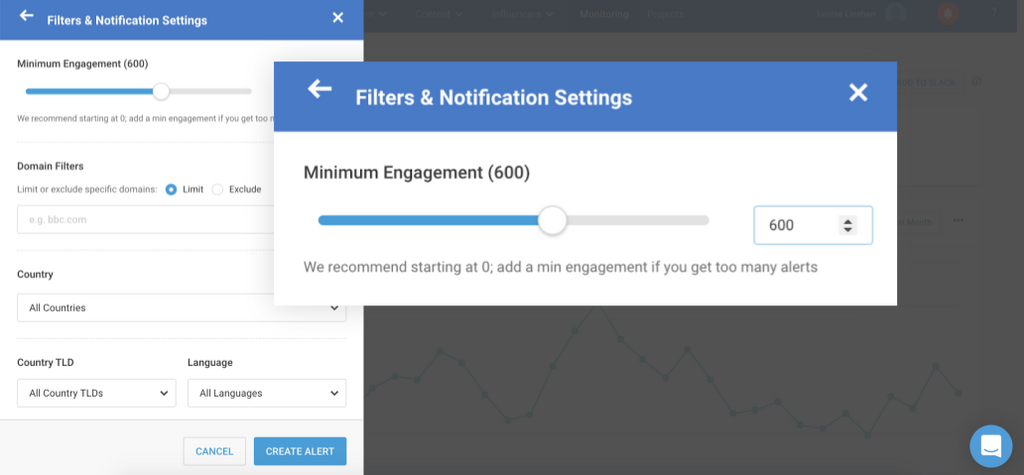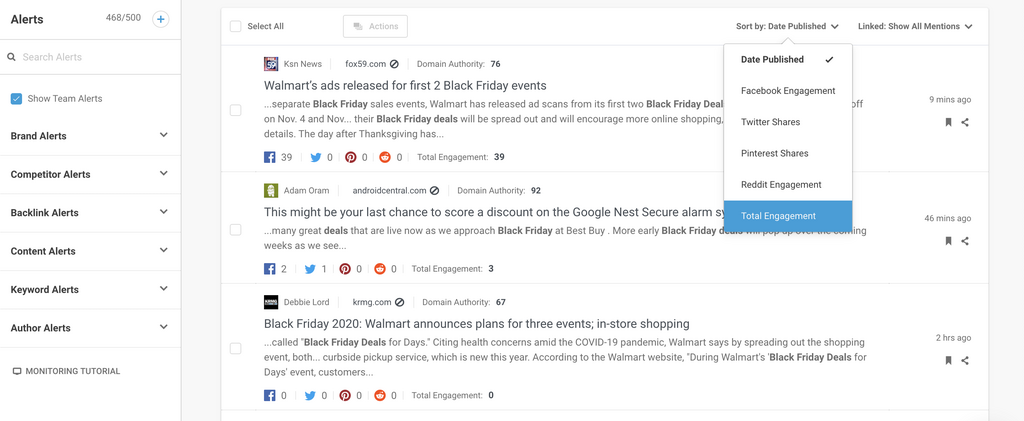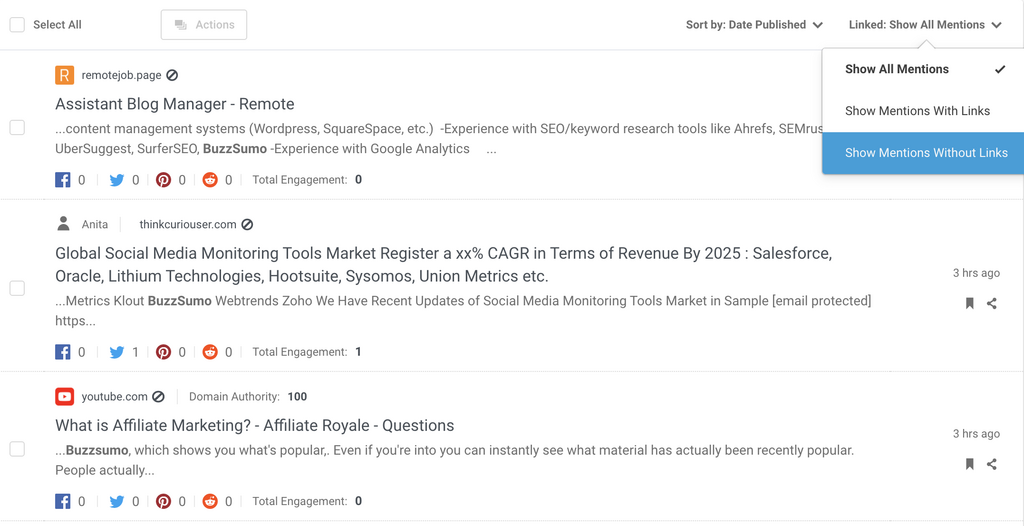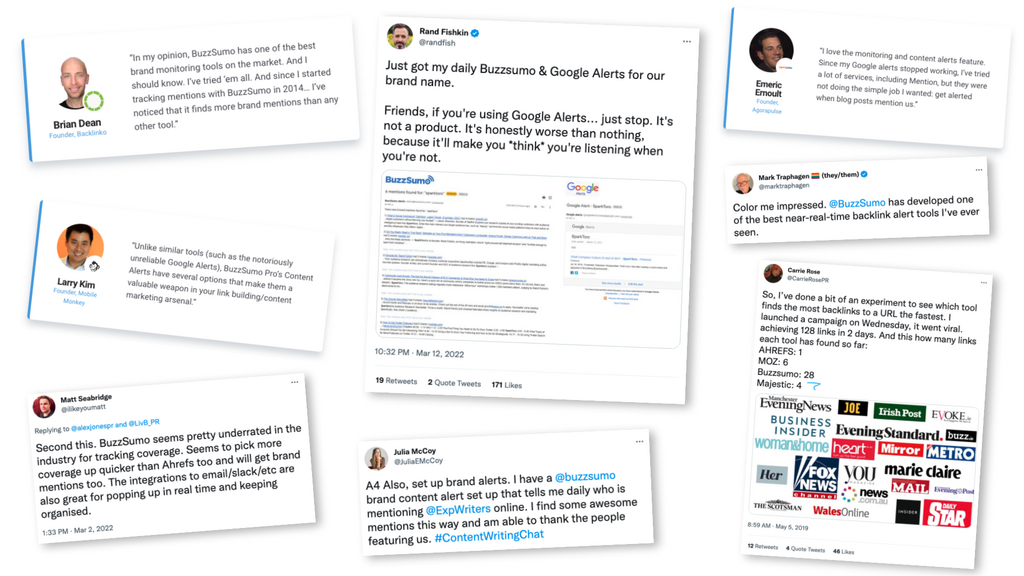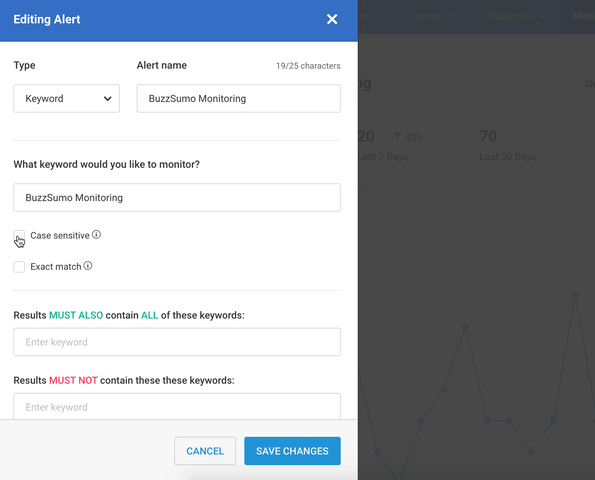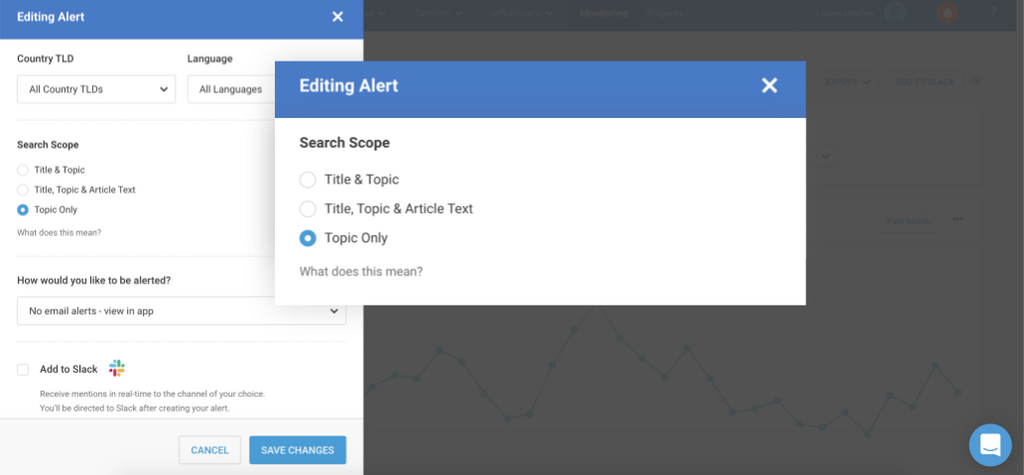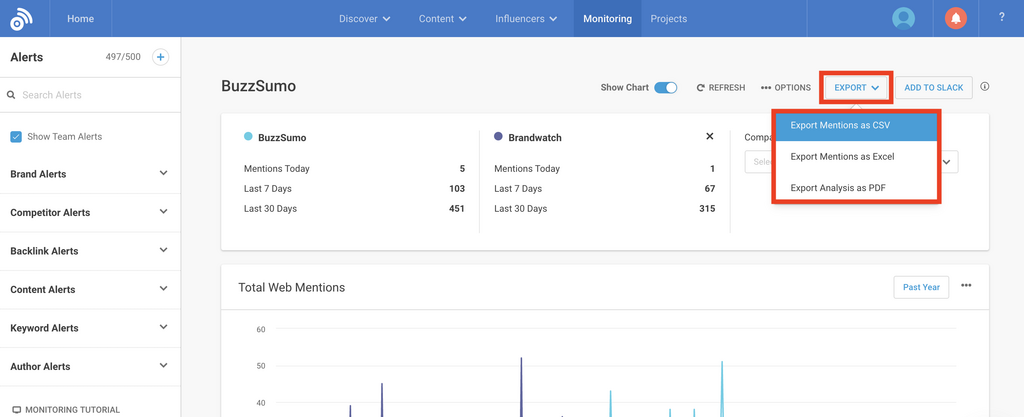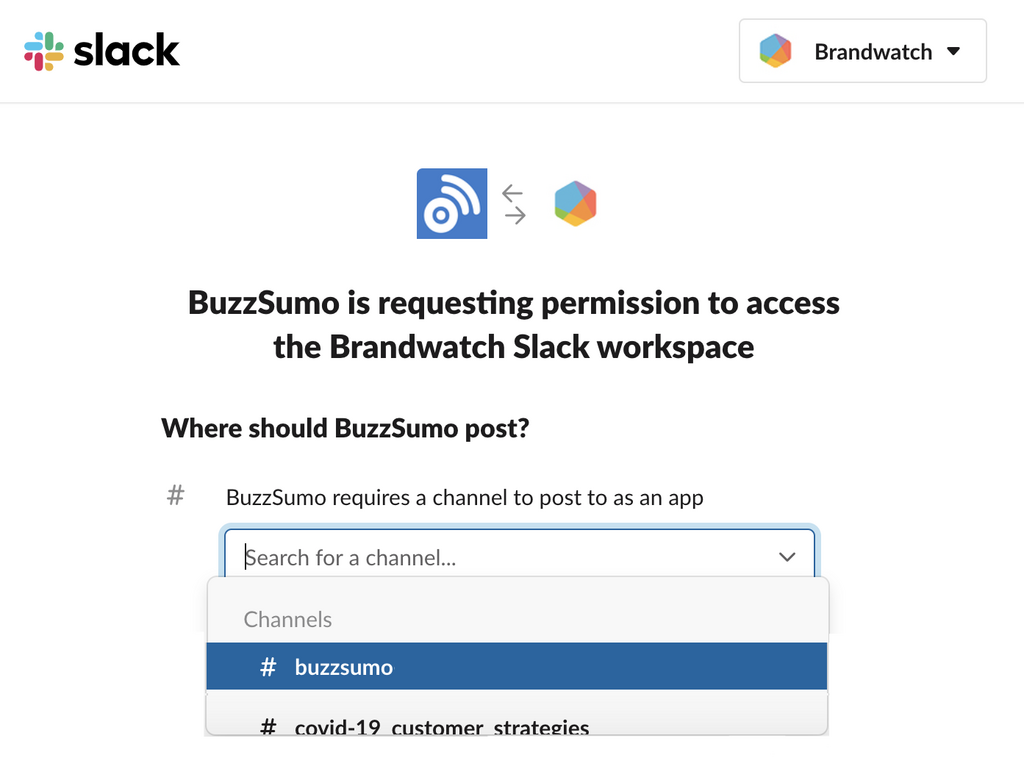There’s no denying that Google Alerts are awesome, but how do BuzzSumo Alerts compare?
Whether you’re trend spotting, measuring PR or managing a crisis, having alerts set-up is critical to the success of your business.
So, let’s get straight to it. Here are six reasons BuzzSumo Alerts make a great Google Alerts alternative.
1. Speed
BuzzSumo Alerts are super speedy. Whether you’re managing a crisis or searching for new brand opportunities, if speed to insight is your top priority, then BuzzSumo is your go-to tool.
Testing the speed of BuzzSumo Alerts vs. Google Alerts
To test speed, I set up a simple keyword alert both in BuzzSumo and in Google Alerts. I made sure that any mentions were delivered to my inbox as soon as they occurred.
I set these alerts up at nearly exactly the same time, on the same date.
Overnight, I have received 12 standalone alerts of mentions from BuzzSumo Alerts, for the keyword: BuzzSumo.
I have yet to receive any alerts from Google.
To make sure the test was fair, I double checked the configuration of my Google Alert, and researched whether anything could be preventing mentions from coming through (eg whether the capital ‘S’ in BuzzSumo was skewing the results).
That didn’t seem to be the case. Google reads all mentions as lower case, and will return exact match mentions if the keyword is surrounded by quotation marks.
And before you ask, I did check my spam and promotions folders!
So, when it comes to the speed of alerts, it’s:
BuzzSumo: 1
Google Alerts: 0
This test may not seem that significant, but the speed of acquiring information around your brand can spell the difference between you making a return on your investment, or wasting your time.
Think of it like this. If a negative news story is published about your brand and you come across it on Monday afternoon instead of a Friday morning, the damage could already be done in the eyes of your customers or clients.
Whether it’s an opportunity or a disaster, knowing information at speed can help you take action before anyone else – including your competitors.
This exact scenario played out for Collins Online Marketing Services. Thankfully, CEO Terence Collins used BuzzSumo Alerts, and was able to successfully prevent fallout from a piece of negative press:
“I had one case where a well-regarded competitor published a controversial article. A BuzzSumo alert tagged it in the evening, and we had created a rebuttal and had it on the desk of our client’s Marketing Manager, ready to publish, by 8 am the next morning. Client for life on that one. BuzzSumo’s alerts allow us to watch competitors and industry leaders. We see what they publish, how well it’s shared, and can either hop on a trend, counter it, or ignore it. Instantly. We can now respond in hours rather than days or weeks.”
CEO Terence Collins of Collins Online Marketing Services
Still need convincing? Here’s what other industry experts have to say on the matter…
“BuzzSumo has so far been the fastest tool at finding backlinks to a URL.”
Carrie Rose, Rise at Seven
In fact, Carrie did a whole Twitter study on BuzzSumo’s backlink monitoring speed:
So, I’ve done a bit of an experiment to see which tool finds the most backlinks to a URL the fastest. I launched a campaign on Wednesday, it went viral. achieving 128 links in 2 days. And this how many links each tool has found so far:
— Carrie Rose (@CarrieRosePR) May 5, 2019
AHREFS: 1
MOZ: 6
Buzzsumo: 28
Majestic: 4 pic.twitter.com/ZtqofkAOZ8
“One of the Pro features of BuzzSumo is their content alerts. We set up content alerts for our brand name and my name, too! You could also set up content alerts for competitors. What I have found is that these alerts are far more comprehensive than other alert applications and they arrive very quickly after the link appears (e.g. sometimes in under an hour).”
Razor Social
“I’ve found BuzzSumo’s content alerts much more useful than Google alerts. You can set it up to send you alerts any time a specific brand is mentioned on any channel or when someone links to a page on a brand’s or a competitor’s website. The platform catches these mentions and links almost instantly.”
Tanya Lewis, PR Week
Back to Contents
2. Prioritization
Now, we may be biased, but we think this part is where BuzzSumo really comes into its own.
Google Alerts are free, and there’s no denying that is a big tick in their favor.
But BuzzSumo, with its entire suite of powerful marketing tools, comes into its own in providing context and helping you with your next steps.
And this is arguably the most important thing when it comes to building an ROI-led PR monitoring strategy.
Prioritizing alerts by social engagement:
BuzzSumo Alerts: ✅
Google Alerts: ❌
The BuzzSumo suite was built on social engagement. When you invest in BuzzSumo Alerts, you’re also gaining access to the world’s largest index of social engagement data – as well as a bunch of other hugely robust tools, including Trending, Content Analyzer, Backlinks, Top Authors and Influencers.
Knowing where to start with your mentions is half the battle, and social data gives you that context.
It means you can find stories around your brand that are snowballing, and gaining real engagement.
Although Google Alerts doesn’t provide this extra layer of insight, it does offer some level of prioritization with the option to showcase “Only the best results.”
It’s not 100% clear how Google prioritizes the best results here, but it does narrow your mention data, so that it’s easier to find the good stuff!
Social and content engagement is the kind of vital insight that is worth paying for. It saves you time, money, and can fuel your content, brand, and PR strategies.
“[BuzzSumo] Value Add! The PR team can prove the value of a media mention using social data. Google Alerts is a great tool for PR professionals, but does not give them information about social shares.”
Ali Freezman, Seer Interactive
What do we mean by social engagement? In BuzzSumo, every piece of content you come across – every headline, infographic, video, podcast – is analyzed across major social media networks for its relative engagement; including likes, shares, and comments.
With this data, you can better optimize your time by zoning in on the most popular and important mentions.
To prioritize by engagement you can do two things:
1. Configure minimum engagement alerts
Setting up your BuzzSumo Alert can often generate a huge number of mentions, so during alert set up you also have the option to set minimum engagement levels, to give greater focus to the top mentions in your inbox.
2. Sort mentions by total engagement or network engagement
In the BuzzSumo Monitoring part of the platform, you can also order engagement with the ‘Sort by Total Engagement’ filter – or any other social network engagement for that matter.
Prioritizing by engagement helps you find:
Your most important brand mentions
- Find out if you’ve been featured in a piece of positive national news that has engaged audiences across the country, and use this in your marketing, as social proof for your business.
Your most important competitor mentions
- Find out if your clients’ competitors have been mentioned in an article that is gaining big traction on social, and get in touch with the author to pitch your client’s product / service.
Your most important keywords
- Discover popular trending topics that are important to your client, and use this knowledge to pitch new campaign ideas that will hit the mark.
Your most important backlinks (domain & URL)
- Discover the most engaging content that is linking to your brand or your client's brand, to find your best SEO advocates.
Your most important content (domain & URL)
- Monitor all the most engaging mentions of a piece of content (URL) written by your brand, client, or competitor to analyze success and bank ideas for future reference.
Your most important authors
- Monitor the content mentioning thought leaders, journalists, experts, influencers or celebrities that draw the biggest audience on social, and use this insight to fuel your content or PR strategies.
In short, BuzzSumo Alerts help you separate the wheat from the chaff, and make the right decisions for your business or client at the click of a filter.
This makes it a great alternative to Google Alerts.
Finding unlinked mentions
BuzzSumo Alerts: ✅
Google Alerts: ❌
Google Alerts flag all mentions, linked or otherwise, and there’s no denying that’s an awesome thing.
But what if you’re wanting to home in on new link opportunities specifically?
Whether you’re optimizing your content to make it more powerful in the eyes of Google, or boosting referral traffic to a clients’ campaign, it’d take some time to sift through alerts and home in on unlinked mentions manually – especially if your alert is for a broad topic, or if your brand / client is kind of a big deal.
In your Monitoring dashboard, BuzzSumo lets you sort by unlinked mentions to help you automatically unearth these quick-win opportunities.
So, not only do BuzzSumo Alerts give you speed to insight, they also give you speed to value.
“My favorite tool for monitoring backlink opportunities in real-time is Buzzsumo.”
Matt Zajechowski, Digital Third Coast
Ability to see domain authority
BuzzSumo Alerts: ✅
Google Alerts: ❌
Another prioritization layer BuzzSumo offers is the ability to assess the domain authority of the websites mentioning you.
If traffic to your own or your clients’ content is top of your agenda when it comes to PR monitoring, then focusing on websites with top domain authority is a winning strategy.
The higher the domain authority of a site (out of 100), the more likely it is to pass on value to your content when it links to you.
Domain authority should be especially important for you if you’re setting up alerts to support your PR strategy.
As Rudi Davis from Publicize writes:
“PR and SEO work hand-in-hand these days. When a business wins a piece of earned media in an online publication, this usually includes a backlink to their website. And backlinks still remain a vital ranking factor.”
Back to Contents
3. Scope and reliability
BuzzSumo Alerts are as comprehensive as they come, helping you to unearth mentions that some tools struggle to find.
Google Alerts are also super generous in their capacity. You can receive alerts up to a limit of 1k, which is pretty significant.
But, When it comes to both scope and reliability, many industry experts find BuzzSumo Alerts give that little bit extra.
Hear from the experts:
Brian Dean
“In my opinion, BuzzSumo has one of the best brand monitoring tools on the market. And I should know. I’ve tried ‘em all. And since I started tracking mentions with BuzzSumo in 2014… I’ve noticed that it finds more brand mentions than any other tool.”
Larry Kim
“Unlike similar tools (such as the notoriously unreliable Google Alerts), BuzzSumo Pro’s Content Alerts have several options that make them a valuable weapon in your link building/content marketing arsenal.”
Emeric Ernoult
“I love the monitoring and content alerts feature. Since my Google alerts stopped working, I’ve tried a lot of services, including Mention, but they were not doing the simple job I wanted: get alerted when blog posts mention us.”
Carrie Rose
“It [BuzzSumo] finds links the fastest as well as links no other tool has found (the hidden ones)”
John Jantsch
“Alerts have been with us for a while. The original player was Google Alerts. With this feature, you can create a list of things such as brand names, product names, competitors, journalists and even key employees and receive daily digests for any mentions. I switched from Google Alerts to Talkwalker a few years ago, but I believe BuzzSumo’s alerts are even more complete so I use this tool for my alerts as well.”
4. Precision
The precision of your alerts can determine the success of your strategy.
For example, what if you were focusing on brand health or protection, and wanted to monitor whenever a competitor mentioned your brand name, to mitigate the effects of smear campaigns?
This is an example of a fairly precise use case and alert type. If your alerts didn’t support this type of analysis, then you wouldn’t be able to meet your brand defense objectives.
Thankfully, both BuzzSumo Alerts and Google Alerts offer this.
Setting up precise alerts for PR monitoring
BuzzSumo Alerts: ✅
Google Alerts: ✅
Both tools permit you to set up text and domain alerts around your:
- Brand
- Backlinks
- Competitors
- Keywords
- Content
- Authors
You can also tailor your alerts to your objectives on both platforms, by applying different configurations.
This is how BuzzSumo’s Alert set up compares against Google:
Configuration options |
BuzzSumo Alerts |
Google Alerts |
|---|---|---|
| Intuitive set up | ✅ | ❌ |
| Case sensitive keywords | ✅ | ❌ |
| Language | ✅ | ✅ |
| TLD | ✅ | ❌ |
| Exact match keywords | ✅ | ✅ |
| Title, topic, and article text monitoring | ✅ | ❌ |
| Minimum engagement | ✅ | ❌ |
| Additional keywords | ✅ | ✅ |
| Negative keywords | ✅ | ✅ |
| Website URL exclusions | ✅ | ✅ |
| Website URL isolation | ✅ | ✅ |
| Country | ✅ | ✅ |
| Sources (blogs, news, web, finance etc.) | ❌ | ✅ |
The big difference here is that with Google Alerts you need to use manual search parameters to set up anything other than a straightforward alert.
Eg exact match searches must be written within “quotation marks”, while -negative mentions must include a minus sign before the keyword that needs to be omitted.
These rules aren’t always easy to remember and can be hard to find, meaning many people don’t know they exist – and are getting a lot less value out of their alerts as a result.
BuzzSumo’s alert set up is highly intuitive, and walks you through every precise alert option above, so you don’t miss out on any important information.
BuzzSumo bonus features
BuzzSumo also gives you the ability to set up case-sensitive alerts and prioritize a mention based on its placement within a piece of content.
The latter is essential for objective-focused analysis. By default, Google Alerts look for mentions anywhere within a piece of content.
If you are monitoring a broad keyword, this could return a lot of non-relevant alerts.
BuzzSumo defaults to a more focused view, prioritizing just the title & topic, not article text – although you can definitely choose that option.
If your client’s brand shares a name with a common word, choosing the title & topic filter can give you better brand-focused mentions.
Take Apple as an example. When we set up an alert for this brand name by title, topic & article text, we got 115,083 mentions over the past week. Switching to just the title & topic returns a fourth of that, with 26,031 mentions.
And you can target ambiguous mentions in even more detail, with minimum engagement and negative keyword settings.
BuzzSumo Alerts also help you find content tagged to hashtags, using just the topics filter alone.
Back to Contents
5. Trend insight
BuzzSumo Alerts: ✅
Google Alerts: ❌
This one’s a BuzzSumo-only offering.
When you’ve set up your BuzzSumo Alert, it gets backfilled with a month’s worth of mention data, and continues to record from then on.
With this data, BuzzSumo creates a visualization of total web mentions that helps you see trends in publicity and content over time.
With options to compare alerts (see above), and download PNGs, PDFs, SVGs and more, this makes for a perfect PR reporting resource in your team meetings! You can also download Excel docs and CSVs of your mentions – but more on that later.
BuzzSumo helps you quickly prove the value of your PR, crisis management, content, or brand efforts, with mention visuals that are instantly understandable.
Use it to make a speedy assessment on the value of:
- Seasonal / one-off events (ie Halloween content, Black Friday campaigns)
- Competitor activity (ie mergers and acquisitions)
- PR campaigns (ie client press releases)
- Product demand (ie product releases)
- Issue management (ie see how past issues played out to inform crisis planning)
Back to Contents
6. Next-step actions
Exporting Alerts
BuzzSumo Alerts: ✅
Google Alerts: ❌
Google Alerts may show you hundreds of mentions, but you can’t yet export them without setting up an RSS feed.
With BuzzSumo Alerts, you can download a CSV, Excel doc, or PDF of your chosen mentions and engagement metrics generated by your alerts, whenever you want.
The smallest paid plan in BuzzSumo offers 50 exports, while the largest provides 400. That’s a lot of PR monitoring insight. See more about BuzzSumo’s pricing and plans here.
Use these CSVs as:
- Link building checklists: Work through your unlinked mentions, contacting authors and journalists to offer something of value (ie a story, unique statistic, chart etc) in return for a do-follow link.
- Outreach checklists: Make this your starting point for contacting influencers or authors.
- Campaign proof points: Showcase your hard earned media results to your clients and team. Slice, dice, and visualize mentions and engagement data how you want.
“Google doesn’t make it easy to export alerts to a spreadsheet. In fact, Google doesn’t allow you to export alerts as CSV or XLS at all. All that Google can do is send you an email when a new result matches your search criteria.” Sylvestre Dupont, Parseur
Share Alerts via email
BuzzSumo Alerts: ✅
You can get BuzzSumo Alerts sent to numerous email addresses, meaning you can keep your team informed of important publicity, or set up alerts for your clients.
Google Alerts: ❌
You can get Google Alerts delivered to the email address of the person that created the alert. To share Alerts, you would need to forward them on.
Share Alerts via Slack
BuzzSumo Alerts: ✅
BuzzSumo Alerts can be easily integrated into Slack during the Alert set up process, to instantly notify your team or clients of mentions. Just set up a channel on Slack and select it from the list – job done.
Google Alerts: ✅
Google Alerts can be integrated with Slack using an RSS feed, and shared from there on. It involves setting up an RSS Feed, downloading an RSS page in the Slack App Directory, adding an RSS integration, pasting in your RSS URL, and subscribing to the feed.
Integrate alerts via an RSS feed
Google Alerts: ✅
As you already know, Google Alerts can be set up to create an RSS feed. This enables you to view your Alerts via a source you already use, and receive up to date news and content. Just change the delivery option to ‘RSS feed’, hit ‘Create alert’, then click on the RSS icon and copy the RSS URL to take it with you to your app of choice.
BuzzSumo Alerts: ✅
BuzzSumo Alerts can also be set up via an RSS feed, enabling you to integrate your mention data with IFTTT (If This Then That), SMS, Google Spreadsheets, or basically any app you can imagine. Just head to your chosen alert, click ‘Options’ and ‘RSS – copy link’.
“Because BuzzSumo offers RSS feeds for all of your alerts, you can set up an IFTTT (If This Then That) formula to push all media mentions into a Google Doc. If the PR team prefers an excel spreadsheet, you can export the alerts as a CSV.”
Ali Freezman, Seer Interactive
Back to Contents
Closing thoughts
The thing is, while we’re obviously going to tell you how AWESOME BuzzSumo is, this isn’t really an “Either / Or” choice.
You can use both Google Alerts AND Buzzsumo Alerts in tandem – in fact, we actively encourage it.
Google Alerts are powerful and a great free option. They are the perfect top-up to a paid tool like BuzzSumo.
But, the fact remains that Google Alerts don't pick up on all mentions and links. BuzzSumo finds content that gets shared to social media, as well as the web, so it's a less likely to miss a mention.
BuzzSumo also adds an extra level of engagement insight, and it’s this insight that shows you how to build real value into your PR monitoring strategy.
If you want to know more, you can read about how to use BuzzSumo here.
Still need to see it for yourself? Test-drive BuzzSumo Alerts via a 30 day free trial.
Already convinced? Head to the BuzzSumo pricing page for information on our plans.
Categories
BuzzSumo ToolsThe Monthly Buzz⚡
Subscribe to BuzzSumo's monthly newsletter to:
Stay up-to-date with the best of the best in content marketing 📝
Get data-informed content, tips and tidbits insights first 👩🏻💻
Read top shared content by top marketing geeks 🤓
Try
Enter any topic, term or url to search to see BuzzSumo in action. It’s free!
100% free. No credit card required.



